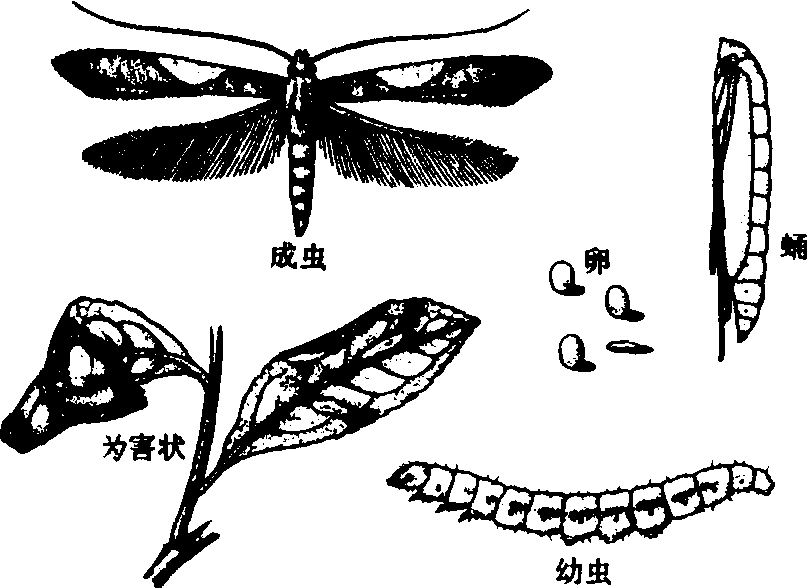茶细蛾tea leaf roller
茶树芽叶害虫之一, 属鳞翅目细蛾科, 学名为 Caloptilia theivoraWalsingham。
分布与为害 全国各产茶省均有分布, 日本、印度、斯里兰卡等国亦有发生, 日本茶树受害较重。幼虫在新梢嫩叶上潜食叶肉,留下上下表皮透明条痕;或自叶尖卷成三角苞匿居苞内咀食,不仅影响茶叶产量,而且黑色虫粪污染芽叶, 对成茶品质影响颇大。
形态 成虫体长4~6毫米, 翅展10~13毫米,头、胸暗褐色, 腹部背面暗褐色, 腹面全黄色,前翅褐色,带有紫色光泽, 近中央有一金黄色三角形斑; 后翅暗褐色, 缘毛长。卵椭圆形, 长径0.3~0.5毫米, 无色透明, 具水滴光泽。幼虫初孵时体扁平, 乳白色, 半透明, 后期体呈圆筒形, 黄白或白色, 体上生有白色细毛,成长后体长8~10毫米。蛹长5~6毫米,圆筒形,头顶有三角形突起一个, 背面淡褐色, 翅芽和腹面淡黄色, 蛹外有灰白色长椭圆形茧。

茶细蛾
生活习性 在浙江一年发生7~8代, 以蛹在茶叶背面越冬, 各代幼虫为害期分别在4月上旬至5月上旬、5月下旬至6月中旬、6月下旬至7月上旬、7月中旬至8月上旬、8月中旬至9月上旬、9月中旬至10月中旬、10月下旬至11月下旬。气候对其发生影响较大, 全年以6月前后第二、三代发生最重, 夏季因高温干旱虫口明显下降: 秋季气温下降雨量增多后又逐渐回升, 10~11月间亦有相当为害。成虫有趋光性,停息时侧面观呈“入”字形。卵散产于嫩叶背面。幼虫为害按其习性可分为三个阶段: ❶1、2龄为潜叶期, 幼虫潜入叶内取食叶肉危害, 叶背出现弯曲带状灰白色潜痕;
❷3龄和4龄前期为卷边期, 幼虫在叶内吐丝将部分叶缘向背面卷折, 虫体藏于卷边内取食叶肉;
❸4龄后期和5龄为卷苞期, 幼虫从卷边中咬一孔洞爬出, 吐丝将叶尖向叶背卷结成三角形虫苞, 栖息于苞内取食危害。老熟后从三角苞内穿孔爬出, 移至下方叶背面吐丝结茧化蛹。
防治 结合采摘除幼虫。喷施90%巴丹1000~1500倍液或10%二氯苯醚菊酯,2.5%溴氰菊酯, 20%杀灭菊酯6000~8000倍液, 25%喹硫磷1000倍液, 50%辛硫磷或80%敌敌畏800~1000倍液,喷药需在卷苞前进行, 尤以潜叶期效果最好; 幼虫期以锥腹姬小蜂寄生较多, 应加以保护。
茶细蛾tea leaf roller
Caloptilia theivora Walsing-ham,鳞翅目,细蛾科。日本、印度、斯里兰卡和中国各茶区均有分布。成虫翅展10~13 mm,体暗褐,前翅具紫色光泽,近中央有一金黄色三角形斑,后翅缘毛长。末龄幼虫体长8~10 mm,乳白至黄白色,腹足4对。年发生7~8代,以蛹茧在叶背越冬。成虫有趋光性,停息时虫体竖立。卵散产于嫩叶背面。幼虫1、2龄潜食叶肉,3、4龄吐丝卷缀叶缘藏身,4~5龄自叶尖反卷成三角苞居中为害。可结合采茶摘除幼虫;幼龄期喷药防治。